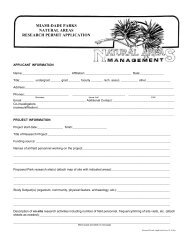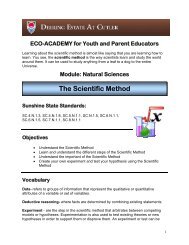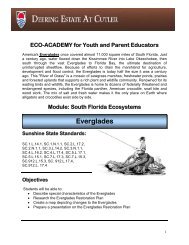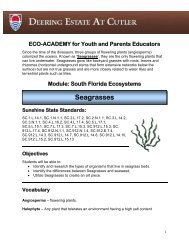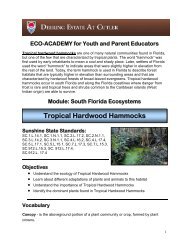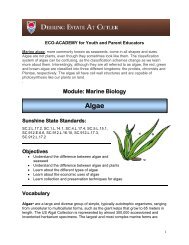Pine Rockland Lesson Plan 2 - Deering Estate at Cutler
Pine Rockland Lesson Plan 2 - Deering Estate at Cutler
Pine Rockland Lesson Plan 2 - Deering Estate at Cutler
You also want an ePaper? Increase the reach of your titles
YUMPU automatically turns print PDFs into web optimized ePapers that Google loves.
<strong>Pine</strong> rockland fires are surface fires th<strong>at</strong> have minimal effects on the pine canopy. The<br />
primary source of n<strong>at</strong>ural fire in pine rockland systems is lightning. The majority of<br />
lightning-caused fires occur between May and September, with larger fires in the early<br />
part of the wet season. The shortest fire interval could be 2 to 3 years, the longest<br />
interval 10 to 15 years with most researchers in agreement th<strong>at</strong> pine rocklands typically<br />
burn twice per decade. The estim<strong>at</strong>ed proper fire frequency <strong>at</strong> 3 to 7 years, although it<br />
has been suggested th<strong>at</strong> a fire interval of 3 to 7 years may be too frequent for young<br />
pines to <strong>at</strong>tain a large enough size to survive a fir. .<br />
The South Florida slash pine is very resistant to fire. Seedlings of the South Florida<br />
slash pine have the ability to resprout from the root collar after a surface burn, while the<br />
northern variety is without this adapt<strong>at</strong>ion. It also has long needles which shield apical<br />
buds, and a thick bark which protects the inner bark and cambium (Byram 1948, Hare<br />
1965). <strong>Pine</strong> seedlings have better survival r<strong>at</strong>es in areas of low duff accumul<strong>at</strong>ion, and<br />
seedling establishment can be improved when fires occur soon before seed release,<br />
typically in October. If fires occur after seed release then seeds are killed.<br />
Many herbs and shrubs resprout or grow rapidly after fire, and shrubs are seldom killed<br />
by a single fire. Fire may also stimul<strong>at</strong>e flowering in these group. Fire response may<br />
vary dram<strong>at</strong>ically depending on the time of year of the fire event. In a study of fire<br />
effects on 36 pine rockland plant species, 21 showed no alter<strong>at</strong>ion in post-fire flowering<br />
or fruiting p<strong>at</strong>terns. Species with reduced flowering or fruiting activity included the eight<br />
hardwood shrubs. Six species exhibited an increase in flowering and fruiting activity in<br />
the 9 months following a fire. Other study shows th<strong>at</strong> hardwood recovery was not<br />
affected by season of burning. Instead, recovery was affected by fire intensity. Reports<br />
say th<strong>at</strong> fruiting of shrub species is reduced after a fire, and th<strong>at</strong> repe<strong>at</strong>ed burning may<br />
also exhaust root reserves. Almost all herbs in pine rocklands are perennials which<br />
resprout quickly after fires. It was reported th<strong>at</strong> herbs regained their pre-fire biomass 7<br />
months after a dry season burn and 1 year after a wet-season burn. Annuals or<br />
biennials which do not resprout following fire include false-foxglove and tiny polygala.<br />
The theoretical succession rel<strong>at</strong>ionship between pine rockland and tropical hardwood<br />
hammocks has been much discussed. It has been reported th<strong>at</strong> in the absence of fire,<br />
pine rockland will succeed to tropical hardwood hammock in 20 to 30 years but th<strong>at</strong><br />
succession may be slowed if less hammock is present in the vicinity of the pine<br />
<strong>Rockland</strong>. However, it has been reported th<strong>at</strong> hammock size and shape stays<br />
remarkably constant over time. Since fire is a n<strong>at</strong>ural function in the South Florida<br />
Ecosystem, virtually all hammock expansion into pine rocklands in the absence of fire<br />
would have to be <strong>at</strong>tributed to anthropogenic factors.<br />
Conserv<strong>at</strong>ion Thre<strong>at</strong>s<br />
Thre<strong>at</strong>s to <strong>Pine</strong> <strong>Rockland</strong> habit<strong>at</strong> th<strong>at</strong> were also identified for multiple other habit<strong>at</strong>s are<br />
addressed in the Chapter Multiple Habit<strong>at</strong> Thre<strong>at</strong>s and Conserv<strong>at</strong>ion Actions. These<br />
thre<strong>at</strong>s include:<br />
• Chemicals and toxins<br />
13




